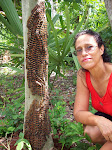
HIGH-TEMPERATURE SUPERCONDUCTIVITY
In the late 1980s physicists were astounded by the electrical behavior of ceramic compounds based on copper oxides. These materials could conduct electricity without resistance well above the temperature of liquid nitrogen (77 kelvins, or –196 degrees Celsius). Previously, superconductivity occurred only in metals cooled to near absolute zero (–273 degrees C). (The image shows a magnet levitated by the powerful magnetic field of opposite polarity generated by a copper-oxide superconductor cooled by liquid nitrogen.)
The relatively high transition temperature seen in the copper oxides revolutionized the field and forced physicists to reconsider the accepted cause of superconductivity, called the BCS theory. It posited that the supercurrent occurred when electrons paired up. One electron moving through the substance would slightly pull together the material's positively charged crystal lattice, leaving a wake of slightly denser positive charge behind it; a second electron would be attracted to this wake. In this way, these so-called Cooper pairs of electrons became weakly bound together, and a sea of them could flow through the lattice without losing energy. But the theory also predicted that, above about 30 K, ambient heat would cause the lattice to vibrate too much, destabilizing the Cooper pairs.
The copper oxides, which can superconduct at temperatures reaching 164 K under the right circumstances, clearly indicated that a new theory was needed. Cooper pairs were still being formed, but just what brought and kept them together has eluded definitive explanation. The discovery of iron-based superconductors, which also function well above absolute zero but below the copper oxides, could provide some essential clues.









No comments:
Post a Comment